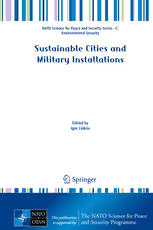
Sustainable Cities and Military Installations PDF
Preview Sustainable Cities and Military Installations
NATO Science for Peace and Security Series - C: Environmental Security Sustainable Cities and Military Installations Edited by Igor Linkov AB3 Sustainable Cities and Military Installations NATO Science for Peace and Security Series This Series presents the results of scientific meetings supported under the NATO Programme:ScienceforPeaceandSecurity(SPS). The NATO SPS Programme supports meetings in the following Key Priority areas: (1) Defence Against Terrorism; (2) Countering other Threats to Security and (3) NATO, PartnerandMediterraneanDialogueCountryPriorities.Thetypesofmeetingsupported are generally “Advanced Study Institutes” and “Advanced Research Workshops”. The NATO SPS Series collects together the results of these meetings. The meetings are co-organizedbyscientistsfromNATOcountriesandscientistsfromNATO’s“Partner”or “MediterraneanDialogue”countries.Theobservationsandrecommendationsmadeatthe meetings,aswellasthecontentsofthevolumesintheSeries,reflectthoseofparticipants andcontributorsonly;theyshouldnotnecessarilyberegardedasreflectingNATOviews orpolicy. Advanced Study Institutes (ASI) are high-level tutorial courses to convey the latest developmentsinasubjecttoanadvanced-levelaudience Advanced Research Workshops (ARW) are expert meetings where an intense but informalexchangeofviewsatthefrontiersofasubjectaimsatidentifyingdirectionsfor futureaction Followingatransformationoftheprogrammein2006theSerieshasbeenre-namedand re-organised.Recentvolumesontopicsnotrelatedtosecurity,whichresultfrommeetings supportedundertheprogrammeearlier,maybefoundintheNATOScienceSeries. TheSeriesispublishedbyIOSPress,Amsterdam,andSpringer,Dordrecht,inconjunction withtheNATOEmergingSecurityChallengesDivision. Sub-Series A. ChemistryandBiology Springer B. PhysicsandBiophysics Springer C. EnvironmentalSecurity Springer D. InformationandCommunicationSecurity IOSPress E. HumanandSocietalDynamics IOSPress http://www.nato.int/science http://www.springer.com http://www.iospress.nl SeriesC:EnvironmentalSecurity Sustainable Cities and Military Installations editedby Igor Linkov UnitedStatesArmyCorpsofEngineers, Boston,MA,USA 123 PublishedinCooperationwithNATOEmergingSecurityChallengesDivision BasedontheProceedingsoftheNATOAdvancedResearchWorkshopon SustainableCitiesandMilitaryInstallations:ClimateChange ImpactonEnergyandEnvironmentalSecurity Hella,Iceland 3–6June2012 ISBN978-94-007-7172-7(PB) ISBN978-94-007-7160-4(HB) ISBN978-94-007-7161-1(e-book) DOI10.1007/978-94-007-7161-1 PublishedbySpringer, P.O.Box17,3300AADordrecht,TheNetherlands. www.springer.com Printedonacid-freepaper AllRightsReserved ©SpringerScience+BusinessMediaDordrecht2014 This work is subject to copyright. All rights are reserved by the Publisher, whether the whole or part of the material is concerned, specifically the rights of translation, reprinting,reuseofillustrations,recitation,broadcasting,reproductiononmicrofilms or in any other physical way, and transmission or information storage and retrieval, electronic adaptation, computer software, or by similar or dissimilar methodology now known or hereafter developed. Exempted from this legal reservation are brief excerpts in connection with reviews or scholarly analysis or material supplied specifically for the purpose of being entered and executed on a computer system, forexclusiveusebythepurchaserofthework.Duplicationofthispublicationorparts thereofispermittedonlyundertheprovisionsoftheCopyrightLawofthePublisher’s location,initscurrentversion,andpermissionforusemustalwaysbeobtainedfrom Springer.PermissionsforusemaybeobtainedthroughRightsLinkattheCopyright ClearanceCenter.ViolationsareliabletoprosecutionundertherespectiveCopyright Law. The use of general descriptive names, registered names, trademarks, service marks, etc. in this publication does not imply, even in the absence of a specific statement, that such names are exempt from the relevant protective laws and regulationsandthereforefreeforgeneraluse. Whiletheadviceandinformationinthisbookarebelievedtobetrueandaccurate at the date of publication, neither the authors nor the editors nor the publisher can accept any legal responsibility for any errors or omissions that may be made. The publisher makes no warranty, express or implied, with respect to the material containedherein. Preface Reliableandaffordableaccesstosustainableenergy,water,andservicesisinherent to the economic and mission success of small cities and military installations. Acknowledging this, diverse military and civilian organizations are actively pur- suing locally oriented strategies to address energy source sustainability, energy and water resource quality and quantity, the use and reuse of natural resources, andthecapabilityofinfrastructuresystemstomaintainsafe,reliable,andresilient communities. For example, the US DOD is developing a comprehensive strategy for energy, water, and waste sustainability at military installations that is expected to include increased conservation and efficiency measures, alternative fuels and energy sources, and organizational/behavioral or programmatic features. A key concern for planners, however, is that climate change and other environmental stressors may radically impact the efficacy of otherwise sustainable strategies for these communities. In the face of uncertain climatic change and future resource availability, small cities and military installations must seek ways to factor future changes and potential stressors into energy, water, and infrastructure strategies to minimizevulnerabilityandincreaseoverallresiliency. TheideaforthisbookwasconceivedattheNATOAdvancedResearchWorkshop (ARW)on“SustainableCitiesandMilitaryInstallations”heldJune2012inHella, Iceland.Theworkshopwasattendedby50scientists,engineers,andpolicymakers representing 15 different nations and multiple fields of expertise, reflecting the global and interdisciplinary nature of climate and sustainability research. The workshop focused on identifying ways for military installations and small cities to integrate energy, water, and infrastructure sustainability strategies into city and installationmanagementplanninginawaythataccountsforclimateuncertainties. Discussions centered on the application of current and emerging technologies, methods,andframeworkstosustainabledevelopment;energyinfrastructure;climate change; environmental impacts; installation security; and military readiness. The workshophadfourprimarypurposes: • Summarizing the state of science related to small city and military installation sustainability v vi Preface • Sharinganddevelopingstrategies,methods,andframeworksforachievinglong- termsustainabilityincitiesandmilitaryinstallations • Defining how energy, water, and infrastructure technologies and management strategiescanbeintegratedinsustainablemanagementplans • Identifyingspecificresearchneedsforimprovingsustainabilityandresiliencyin thefaceofclimatechangeandotherconstraintsandstressors The organization of the book reflects major topics and discussions during the workshop. Sections review accomplishments, challenges, and knowledge gaps in theareasofenergy,water,infrastructure,andintegration.Eachsectionbeginswith a workshop group summary which reviews principles, ideas, and initiatives that were discussed during the workshop. The remaining content reflects the diverse backgrounds and viewpoints of those in attendance. Part I is a summary of the challenges facing cities and military installations and provides background on the conceptsofsustainability.Inadditiontoreviewingclimate-associatedimpactssuch as floods, wildfires, and rising temperatures, which pose extreme security threats to both militaries and metropolitan areas, this section discusses the complexity of decisionmakinginthesecommunities. Part II discusses the challenges facing water resource managers. This section explores the need for risk management and the roles that value engineering, community engagement, and big data can play in the integration of the water and energy sectors. Currently, the primary issues of concern are water quality and availability and habitat degradation. Key to tackling these issues are the needs to addresswaterresourceplanningacrossspatialandtemporalscalesandobjectives. The section also highlights prevalent decision-making processes and the current stateofwaterresources. PartIIIsummarizesthestateofthescienceintheenergysectorandexploresthe need for an integrated systems approach to planning, energy quality analysis, and long-term, multifaceted energy management solutions. Highlighted in this section are the Army’s Net Zero program and the potential impact of micro-grids on the energylandscape.Inadditiontotechnicalsolutions,potentialfinancial,regulatory, andpoliticalbarriersandsolutionsarediscussed. Part IV discusses the varied range of vulnerabilities facing infrastructure and systems integration. Because of the interconnectedness of infrastructures and the potentialforcascadingeffects,attentionmustbepaidtoidentifying,reducing,and respondingtopotentialthreats.Multi-criteriamappingissuggested,and,becauseof thecomplexityofinfrastructuresystems,amulti-andtransdisciplinaryapproachis encouraged.Infrastructuremodeling,theroleofpoverty,andEuropeancasestudies arepresentedinthissection. Climate change and other stressors are expected to alter the environments in which small cities and military installations operate. To successfully deal with these challenges, current and emerging technologies, methods, and decision and Preface vii managementframeworks,coupledwithresiliencyandincreasedefficiency,mustbe exploredinthecontextofuncertainty.Thisbookaddressestheseissuesandreflects theongoingeffortsofsocietytoexaminethechallengesandsuccessesofsustainable developmentinthefaceofanuncertainfuture. Concord,USA IgorLinkov April2013 Acknowledgments The editors would like to acknowledge Dr. Abou Ramadan (NATO workshop co-director) and organizing committee members (Drs. M. Goodsite, F. Holcomb, M. Merad, G. Pe´tursdo´ttir) for their help in the organization of the event that resultedinthisbook.Wealsowishtothanktheworkshopparticipantsandinvited authors for their contributions to the book. We are grateful to Elisa Tatham for her excellent management of the production of this book. Additional technical assistance in the workshop organization and facilitation was provided by Gordon ButteandSarahThorneofDecisionPartners.Theworkshopagendawaspreparedin collaborationwiththeSocietyofRiskAnalysis.Financialsupportfortheworkshop was provided by NATO. Additional support was provided by the U.S. Army EngineerResearchandDevelopmentCenter,USNavy,USDepartmentofEnergy, theUniversityofIceland,Nord-Star,NovusEnvironmental,BioengineeringGroup, DecisionPartners,andLockheedMartin. ix
